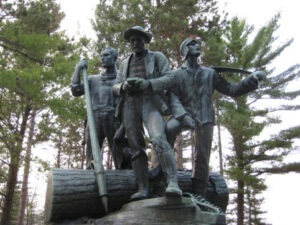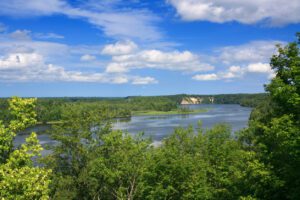Photo courtesy of Shannone Bondie
Oscoda, while technically an unincorporated community, has an interesting history. The region straddles Au Sable Township and Oscoda Township in Iosco County, and includes the mouth of the Au Sable River and shoreline along Lake Huron.
The town’s first post office was established in July 1875, though records from settlers began as early as 1867. Historians believe the name came from geographer/geologist Henry Schoolcraft, as a shortened form of “ossin and muscoda” or a pebbly prairie, according to Wikipedia.
Michigan has designated Oscoda as the official home of Paul Bunyan, thanks to early publications in the Oscoda Press in 1906. The area is also known for Lumberman’s Monument and Wurtsmith Air Force Base.

Iosco County, too, has a long history. According to the Iosco Museum, the county lies “wholly in the tract of land ceded to the (U.S.) by the Chippewa … in the Saginaw Treaty of 1819.”
“When government surveys were made in 1840, the county was called Ka-no-tin,” the museum writes. The name was changed to Iosco in 1843, also influenced by Schoolcraft. The word means “water of light.”
There were less than 200 people living in Iosco County when it was officially created in 1857. The first settlement was called Au Sable, started by fishermen in the late 1840s. Tawas Bay, named for Chippewa Chief O-ta-was, was deemed ripe for a lighthouse in the 1850s. Tawas City was established in 1857, with a mill and dock, general store, dwellings and a post office.
Tawas Township and Au Sable Township were created soon after, according to the Iosco Museum, “dividing the county equally,” and another town — called East Tawas — “sprang up” in 1864. For the next fifty years, lumbering was the principle industry of the region, until a massive forest fire destroyed Au Sable and Oscoda in 1911.
The community leaned on gypsum quarrying and farming, and the number of municipalities expanded. By 1972, the number of residents in Iosco County had grown to 24,905. Today, according to the museum, tourism is the region’s main industry.
“Today the great pine forest is gone, but the magnificent shoreline, the rivers, and inland lakes remain and stretches of (plains) invite you to dream of days gone,” the organization writes.

“Many people who spent their formative years here and then went to the big cities to seek their fortune have returned in their retirement years, where they enjoy the memory of days gone by and hope to enjoy the peace and tranquility and natural beauty which abounds throughout the county.”
